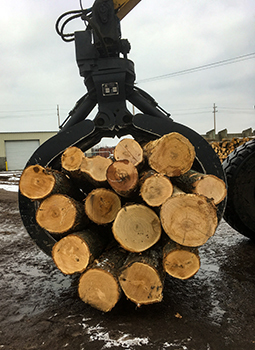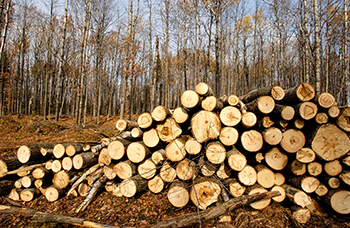Michigan’s forest products industry’s value spikes
By KATHLEEN LAVEY
Communications representative, Forest Resources Division
Michigan Department of Natural Resources
From a furniture factory in suburban Grand Rapids to a paper mill in the Upper Peninsula to a one-employee sawmill operation in the heart of the mitten, Michigan’s forest products industry is growing.
Michigan’s traditional forest products industry – sawmills, paper mills, furniture factories, logging and other wood products manufacturers – reached a combined value of nearly $22 billion in 2019, the most recent year for which statistics are available.

“In 2012, the value of the forest products industry in Michigan was $17.5 billion, so this is a significant increase and is in line with goals set for the industry,” said Jagdish Poudel, forest economist for the Michigan Department of Natural Resources and author of the study on the economics of forest products.
The information in the study can help shape and grow Michigan’s forest-related industries into the future.
“Significant progress has been made growing the forest products industry in the state of Michigan,” said Charlie Becker, chairman of the state’s Timber and Forest Products Advisory Council. “The success can be attributed to our abundant and diverse forests that provide the renewable raw material, the skilled workforce in our manufacturing, logging and transportation sectors, as well as favorable policies that make Michigan a good place to do business.”
The study measures direct employment in the forest products industry as well as indirect employment, which includes jobs that are related to supporting the industry, and “induced effects,” or household spending by people employed in the industry.
Each direct job in forest products industries supported 1.14 additional jobs, the study shows. Direct employment was pegged at 42,011 jobs.
When indirect and induced employment are included, the jobs figure increases to 90,022. The indirect jobs include careers like those of truckers who transport lumber or real estate jobs connected with buying and selling forest lands or restaurant workers who provide food and services.
|

In terms of direct jobs, the leading sectors in the forest products industry include paperboard and container manufacturing (7,122 jobs), wood office furniture manufacturing (4,906 jobs), commercial logging (3,782 jobs) and sawmills (2,843 jobs).
Since the figures are from 2019, they do not account for the impact of the COVID-19 pandemic, which has slowed growth in the forest products industry in other states.
“We won’t see the impact of COVID-19 in this data until next year,” Poudel said.
A study done in Wisconsin suggests that the forest products industry there lost 4.78 percent of direct jobs when comparing 2018 figures with the second quarter of 2020.
However, the plan for growing Michigan’s forest products industry is long-term.
The success shown through 2019 in the most recent Michigan study reflects a decade-long focus on rebuilding since the recession of 2008-2009, which hit the industry hard. That downturn prompted the 2013 timber summit and resulting efforts to boost the industry.
That state of Michigan has its own stake in the industry’s prosperity. The DNR’s Forest Resources Division sustainably manages 4 million acres of state land, preparing about 50,000 acres of timber for sale each year, less than 2% of the total forest acreage.
In 2013 and 2015, Michigan sponsored summit meetings to examine ways to grow the forest products industry. That’s also when the Timber and Forest Products Advisory Council was created to help steer Michigan’s policy regarding the industry.
|

There have been some subsequent wins, including a new particle board plant in Grayling owned and operated by the Chilean company Arauco. It employs about 200 people.
The advisory council had set a goal of guiding the industry to a $23 billion value by 2023.
“We have had a number of new companies invest in Michigan as well as substantial investment from some of our long-time businesses,” Becker said. “The outlook for forestry and the forest products industry in Michigan is very encouraging.”
By the numbers:
- 20.1 million: Acres of forest land in Michigan.
- 55%: Portion of state covered in forest.
- 62%: Privately owned.
- 23%: Owned by state and local governments.
- 15%: Owned by the federal government.
Forest Products Week
The third week of October every year has been designated as Forest Products Week, which this year is Oct. 16-22, to celebrate the renewable resources that forests are and the variety of products they provide.
|

Beyond lumber
We all know that forests provide important wood products such as lumber and paper, but there are many more:
-
Fashion: Rocking a Hawaiian shirt for that upcoming party? Most are made of rayon, a wood pulp product known for its smooth finish and nice drape. Trade names for this fabric include Tencel and Lyocel.
-
Health and beauty: Cellulose from wood pulp is used in toothpaste to keep it cohesive. It also is used in various kinds of lipstick.
-
Food and drink: Maple syrup, apples and cherries – all harvested from trees. Trees contribute to a variety of other products as well. Cellulose powder keeps shredded cheese pieces from sticking to each other. Tree sap, nuts and berries are all used to flavor varieties of beer, and berries from the juniper tree give gin its flavor.
It’s great to celebrate Michigan’s forest resources and industry during Forest Products Week. But it’s even better to realize year-round that Michigan’s forest products industry packs a heck of an economic punch and provides jobs for our people as well as a wide range of diverse goods we can bank on into the future.
|
Check out previous Showcasing the DNR stories in our archive at Michigan.gov/DNRStories. To subscribe to upcoming Showcasing articles, sign up for free email delivery at Michigan.gov/DNREmail.
Note to editors: Contact: John Pepin, Showcasing the DNR series editor, 906-226-1352. Accompanying photos and a text-only version of this story are available below for download. Caption information follows. Credit Michigan Department of Natural Resources, unless otherwise noted.
Text-only version of this story.
Aspen: Aspen logs from a timber sale on state forest land await transport to a processor.
Claw: Machinery is used to move wood from a log pile at AJD Forest Products in Grayling.
Finished lumber: Michigan’s wood products include a wide variety of softwoods and hardwoods, from lumber to veneer to paper products, cardboard packaging and pulp.
Timber machine: A harvesting machine cuts trees on an Upper Peninsula timber job. (Photo courtesy of National Association of State Foresters)
Vertical log pile: Logs from a timber sale await transport. (Photo courtesy of National Association of State Foresters)
|